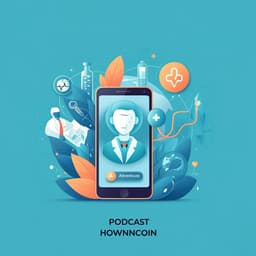
Medicine and Health
Bedtime App-Guided Mindfulness Meditation in Patients With Insomnia: Mixed Methods Feasibility and Acceptability Pilot Study
Y. Ma, P. M. Wayne, et al.
This pilot study explored feasibility of a commercially available bedtime mindfulness meditation app for people with chronic insomnia, combining in-lab polysomnography, at-home actigraphy, daily logs, questionnaires, and exit interviews. Conducted by Yan Ma, Peter M Wayne, Janet M Mullington, Suzanne Bertisch, and Gloria Y Yeh, it found high engagement and preliminary sleep improvements.
~3 min • Beginner • English
Introduction
Insomnia affects up to 30% of the population and carries substantial health and economic burdens. Pharmacologic treatments have risks, and although cognitive behavioral therapy for insomnia (CBT-I) is first-line, access and engagement are limited. Mindfulness-based interventions show promise for improving sleep quality, but existing evidence is heterogeneous with limited mechanistic understanding. Many patients report difficulty initiating sleep due to “racing thoughts,” a cognitive hyperarousal state strongly associated with insomnia severity at bedtime. Mobile mindfulness apps are widely used, and many users report sleep difficulties driven by racing thoughts and stress. However, there are no established guidelines on bedtime use of such apps, and research specifically examining bedtime practice is lacking. This study asks whether app-guided mindfulness meditation practiced at bedtime is feasible and acceptable in adults with chronic insomnia, and whether a hybrid design incorporating both in-lab and at-home assessments can be implemented successfully. The study aims to inform future efficacy and mechanistic trials by exploring feasibility, adherence, and preliminary changes in sleep-related outcomes.
Literature Review
The paper situates insomnia within a broad clinical and public health context, noting adverse outcomes across cognitive function, cardiometabolic health, mental health, and mortality. While CBT-I is recommended, barriers include availability and engagement, prompting interest in app-based alternatives. Existing mindfulness literature (systematic reviews, meta-analyses, and RCTs) suggests benefits for sleep quality and insomnia, but prior studies are heterogeneous, often daytime-delivered, and mechanisms remain unclear. The construct of bedtime cognitive hyperarousal (“racing thoughts”) is highlighted as distinct from rumination and worry and closely linked to insomnia severity. Surveys of Calm app users show high prevalence of sleep problems and racing thoughts. Technology-enabled mindfulness interventions may improve scalability and access, yet bedtime device use is traditionally discouraged by sleep hygiene guidance. The paper identifies gaps: lack of explicit bedtime-focused mindfulness research, insufficient guidance on app use timing and content, and need to integrate objective physiological measures to probe mechanisms.
Methodology
Study design: Single-arm, prospective mixed methods pilot assessing a 4-week app-based bedtime mindfulness intervention in adults (aged 20-50) with chronic insomnia and self-reported difficulty falling asleep. Pre-post measurements included standard in-lab and remote at-home assessments. Reporting followed CONSORT pilot extension (non-RCT criteria excluded). Ethical considerations: Trial registered (ClinicalTrials.gov NCT04242771); IRB approval at Beth Israel Deaconess Medical Center; remote consent via REDCap e-signature; secure data handling; de-identified transcripts; participant compensation up to US$200 and Calm app/parking reimbursement. Eligibility: Inclusion: age 20-50; chronic insomnia per DSM-5/ICSD-3 (≥3 nights/week, ≥3 months, adequate sleep opportunity/environment), self-reported sleep onset latency >20 min; English proficiency; smartphone access. Key exclusions: other sleep disorders; shift/night workers; pregnant/breastfeeding; head trauma/surgery history; regular mind-body practice (≥2x/week); neurological disorders; current medications with neuropsychiatric/cardiovascular effects (e.g., β-blockers, hypnotics, antidepressants). Recruitment and consent: Community fliers and ResearchMatch.org; phone screening by trained research fellow; voluntary participation emphasized; real-time REDCap consent and secure document delivery. Intervention: Participants used the Calm smartphone app nightly at bedtime for 4 weeks. Week 1: “Seven Days of Sleep” introductory program (7 guided MM audio tracks, 12-15 min each) including breathing exercises, imagery, body awareness, muscle relaxation. Weeks 2-4: repeat or choose preferred “Meditation” programs within “Sleep” section (28 programs, >100 tracks of 5-60+ min). Instructions: practice 10-30 min at bedtime; minimize light/digital impacts (dim screen, auto-stop, do-not-disturb, audio-only). Daytime practice allowed but not required. Questionnaires (baseline and post): PSQI, ISI, FIRST, PSAS (somatic and cognitive subscores), DBAS-16, GAD-7, PHQ-9, MAAS. Daily logs: Morning sleep diary (bed/wake times, total sleep, awakenings, sleep quality, stimulant intake). MM adherence logs (frequency/duration, strategies used, program names). Qualitative interviews: Postintervention semistructured interviews addressing experience, acceptability, barriers/preferences, app feedback, perceived helpful components; conducted by one trained interviewer (YM); audio-recorded, transcribed; two reviewers (YM, GY) analyzed using combined inductive/deductive methods; simple responses reported as frequencies; thematic analysis for open-ended responses. Objective sleep assessments: (1) In-lab attended polysomnography at baseline and postintervention (week 5); (2) Ambulatory heart rate monitoring 1 night/week (bedtime routine, MM practice, overnight sleep); (3) Actigraphy for 2 consecutive weeks (week 0 baseline; week 1 intervention), worn continuously on nondominant wrist; event marker pressed before sleep and upon awakening. Statistical analyses: Pilot feasibility emphasis; target n≈12 based on pragmatics for evaluating feasibility metrics. Descriptive statistics; IBM SPSS v25; means/SDs or medians/IQRs as appropriate; discrete data as counts/percentages. A priori feasibility benchmarks: recruit/enroll 12 patients within 12 months; retain >75%; >70% compliance with app use; acceptable intervention per qualitative interviews; analyzable physiological/psychometric data from ≥80% of participants.
Key Findings
Feasibility and adherence: Recruitment (Dec 2022–Jul 2023) screened 37, consented 13; 10 completed (77% retention). Baseline in-lab sleep study completion: 12/12 (100%). Among retained participants (n=10): in-lab studies completion 95% (9/10 postintervention completed; 1 missed due to travel); questionnaires 100%; bedtime app use compliance 91.4% overall (weekly: week 1 95.7%, weeks 2-4 each 90%); sleep logs completion 100% at baseline and 89.6% during intervention; actigraphy completion 100% (weeks 0-1); heart rate monitoring completion 92% overall (weekly 90% except week 4 100%). Acceptability (simple responses): 70% reported no difficulties engaging; 90% reported the app was easy to use; all found audios easy to follow; most preferred shorter sessions (<20 min; 10-15 min favored); most intended continued app use or practicing learned skills at bedtime post-study. Qualitative themes: Presleep barriers included racing/uncontrolled thoughts, loss of control/stress, worry/rumination. Mindfulness benefits/skills: decreased catastrophizing; acceptance, nonreactivity, reduced anxiety; body awareness/relaxation; self-kindness; present-focused attention; awareness of sleep hygiene; improved bedtime routine; earlier defusing of daytime stress; increased focus/presence; daytime calm; incorporating mindfulness into daily activities. App feedback: Likes—breadth of content, multiple options, diverse voices, variable lengths; Challenges—desire for more breath work, audio pacing that could reawaken, cluttered UI/discoverability, need for onboarding/support, initial effort to establish routine, potential boredom over time affecting engagement. Exploratory pre-post self-reported outcomes (n=10): PSQI mean decreased 10.6→6.9; change -3.7 (95% CI -6.7 to -0.7). ISI 14.4→9.9; change -4.5 (95% CI -7.7 to -1.4). PSAS total 39.8→32.1; change -7.7 (95% CI -13.1 to -2.3); Somatic -3.3 (95% CI -6.0 to -0.6); Cognitive -4.4 (95% CI -7.5 to -1.3). FIRST 22.2→19.7; change -2.5 (95% CI -5.9 to 0.9). DBAS-16 5.6→4.4; change -1.1 (95% CI -2.3 to 0). GAD-7 5.0→3.5; change -1.5 (95% CI -3.3 to 0.3). PHQ-9 5.9→3.8; change -2.1 (95% CI -3.6 to -0.7). MAAS 4.21→4.16; change -0.05 (95% CI -0.43 to 0.32). Baseline profile: All had poor sleep quality (PSQI 7–16); ISI categories: 60% subthreshold, 30% moderate, 10% severe; GAD-7 minimal/mild; PHQ-9 minimal/mild.
Discussion
The study demonstrates that a bedtime app-guided mindfulness meditation protocol with hybrid in-lab and at-home assessments is feasible and acceptable in adults with chronic insomnia. High completion and adherence rates across questionnaires, sleep logs, wearables, and app use support scalability of such designs. Participants reported the app easy to use and perceived benefits extending beyond sleep, including reduced catastrophizing and anxiety, increased acceptance and present-focused attention, and enhanced body awareness/relaxation. Qualitative feedback informs future optimization (preferred shorter session lengths, clearer UI, onboarding support, earbud guidance, customization for comorbidities). Exploratory analyses suggest clinically meaningful improvements in sleep quality, insomnia severity, presleep arousal, and sleep-related cognitions, with minimal change in MAAS—potentially reflecting measure insensitivity, brief exposure, or construct mismatch; future studies may consider alternative mindfulness measures (e.g., MAIA/MAIA-2). Remote delivery with wearables reduced participant burden but required structured demonstration/training; feasibility and acceptability in older or less tech-savvy populations warrant further evaluation. The bedtime focus challenges conventional sleep hygiene discouraging device use; study-specific mitigations (audio-only, dim light, do-not-disturb) were implemented, but optimal timing, duration, and content personalization need investigation. The findings complement prior RCTs showing Calm app benefits on sleep-related symptoms and emotional outcomes, advancing a novel line of inquiry into bedtime-specific mindfulness mechanisms and efficacy.
Conclusion
Preset feasibility benchmarks were met, indicating that bedtime app-guided mindfulness meditation for patients with insomnia is feasible and acceptable within a hybrid in-lab/at-home assessment framework. Exploratory self-reported outcomes showed improvements in sleep quality, insomnia severity, and presleep arousal. Future research should include larger controlled trials to evaluate efficacy, refine bedtime app usage guidelines (timing, duration, audio selection, device-light mitigation), expand inclusion to diverse populations, and integrate comprehensive physiological measures to elucidate mechanisms of bedtime mindfulness practice.
Limitations
Single-arm, uncontrolled pilot with small sample size limits inference on efficacy and generalizability. The sample was relatively young (22–50 years), healthy, and well educated; several groups were excluded (pregnant/breastfeeding, children/adolescents, older adults, shift workers, those with comorbid sleep disorders or certain medications), potentially limiting applicability. Allowing non-bedtime app use introduced variability in exposure, complicating attribution of effects to bedtime practice alone. Bedtime device use, despite mitigation strategies (audio-only, dim light), may carry residual risks; further refinement is needed. Feasibility of maintaining a control arm and implementing similar protocols in older, less tech-savvy, or lower-literacy populations remains uncertain.
Related Publications
Explore these studies to deepen your understanding of the subject.







